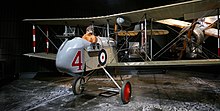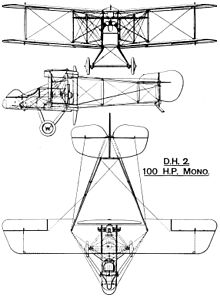Airco DH.2
| Airco DH.2 | |
|---|---|

| |
| Role | Fighter |
| Manufacturer | Airco |
| Designer | Geoffrey de Havilland |
| First flight | July 1915 |
| Retired | 1918 |
| Primary user | Royal Flying Corps |
| Number built | 453 |
| Developed from | Airco DH.1 |
The Airco DH.2 was a single-seat pusher biplane fighter aircraft which operated during the First World War. It was the second pusher design by aeronautical engineer Geoffrey de Havilland for Airco, based on his earlier DH.1 two-seater.
The development of pusher configuration fighters, such as the DH.2 and the
The DH.2 was introduced to frontline service in February 1916 and became the first effectively armed British single-seat fighter. It enabled Royal Flying Corps (RFC) pilots to counter the "Fokker Scourge" that had given the Germans the advantage during late 1915. It served in fighting and escort duties for almost two years, while numerous pilots became flying aces using the type. It became outclassed by newer German fighters, resulting in the DH.2's eventual withdrawal from first line service in France after RFC units completed the process of re-equipping with newer fighters, such as the Nieuport 17 and Airco DH.5, in June 1917.
Development
By the outbreak of the
Early air combat over the Western Front indicated the need for a single-seat fighter with a forward-firing machine gun. At this point in time, there was no dominant approach to arming fighters, but a pusher configuration was one answer.[2] As no means of firing forward through the propeller of a tractor aeroplane was yet available to the British, Geoffrey de Havilland designed the DH.2 as a scaled-down, single-seat development of the earlier two-seat DH.1. Aviation author J.M Bruce speculated that, had adequate synchronisation gear been available, de Havilland may have been less likely to pursue a pusher configuration.[1]
While it is popularly viewed as a response to the emergence of Germany's
Despite the prototype's premature loss, the DH.2 was ordered into quantity manufacture.[6] The production aircraft was generally similar to the prototype with the only major alterations being a fuel system and a revised gun mounting arrangement. Deliveries of the DH.2 commenced during the latter half of 1915 and a handful of aircraft were reportedly operating in France prior to the year's end.[7] A total of 453 DH.2s were produced by Airco.[8]
Design

The Airco DH.2 was a compact two-bay pusher biplane fighter aircraft.
The DH.2 was armed with a single .303 in (7.7 mm) Lewis gun which was mounted on a flexible mount. Once pilots learned that the best method of achieving a victory was to aim the aircraft rather than the gun, it was fixed to fire forward, although this was met with skepticism by higher authorities until a quick-release clip was devised at the Squadron level.[10] The clip was devised by Major Lanoe Hawker, who also improved the gunsights and added a ring sight and an "aiming off model" that helped the gunner allow for leading a target.[11]
The majority of DH.2s were powered by the 100 hp (75 kW)
Operational service


After evaluation at Hendon on 22 June 1915, the first DH.2 arrived in France for operational trials with No. 5 RFC Squadron but was shot down and its pilot killed during early August 1915.[5] This aircraft was recovered and repaired by the Germans.[8] The first squadron equipped with the DH.2, and the first RFC squadron completely equipped with single-seat fighters, No. 24 Squadron RFC, arrived in France early February 1916.[15][9]
The DH.2 eventually equipped seven fighter squadrons on the
The limited ammunition supply of the original gun installation proved to be inadequate.[22] Although officially discouraged, pilots experimented with different gun arrangements, including a fixed twin-gun configuration. Furthermore, the original gun mounting was criticised for being loose and unstable, and it obstructed the stick when elevated. DH.2s were routinely flown with the guns fixed into position.[17]
The arrival at the front of more powerful German
Ace pilots
Distinguished pilots of the DH.2 included
| Pilot | victories |
|---|---|
| Patrick Anthony Langan-Byrne | 10 |
Alan Wilkinson |
10 |
| Selden Long | 9 |
| Arthur Gerald Knight | 8 |
| Eric C. Pashley | 8 |
| John Oliver Andrews | 7 |
| Sidney Cowan | 7 |
| Hubert Jones | 7 |
| William Curphey | 6 |
| Stanley Cockerell | 5 |
| Henry Evans | 5 |
| James McCudden | 5 |
| Robert Saundby | 5 |
| Harry Wood | 5 |
Reproductions

No original DH.2s exist. In 1970, Walter M. Redfern from
Operators
- Royal Flying Corps (Most units operated the DH.2 alongside other types)
Specifications (DH.2)

Data from Warplanes of the First World War - Fighters Volume One,[29]
General characteristics
- Crew: 1
- Length: 25 ft 2+1⁄2 in (7.684 m)
- Wingspan: 28 ft 3 in (8.61 m)
- Height: 9 ft 6+1⁄2 in (2.908 m)
- Wing area: 249 sq ft (23.1 m2)
- Empty weight: 943 lb (428 kg)
- Gross weight: 1,441 lb (654 kg)
- Powerplant: 1 × Gnôme Monosoupape 9-cylinder rotary engine, 100 hp (75 kW)
- Propellers: 2-bladed Integral DG 70 fixed pitch wooden propeller[30]
Performance
- Maximum speed: 93 mph (150 km/h, 81 kn) at sea level
- Endurance: 2 hours, 45 minutes
- Service ceiling: 14,000 ft (4,300 m)
- Time to altitude: 24 minutes, 45 seconds to 10,000 ft (3,000 m)
Armament
- Guns: 1 × .303 in (7.7 mm) Lewis gun
- Rockets: Two examples were equipped with Le Prieur rockets for attacking observation balloons[31]
See also
Related development
- Airco DH.1
- Redfern DH-2 (replica)
Aircraft of comparable role, configuration, and era
Related lists
References
Citations
- ^ a b c Bruce 1966, p. 3.
- ^ Bruce 1966, pp. 3-4.
- ^ a b c d e Bruce 1966, p. 4.
- ^ Mason 1992, p. 42.
- ^ a b Bruce 1966, pp. 4-5.
- ^ Bruce 1966, p. 5.
- ^ Bruce 1966, pp. 5-6.
- ^ a b Airco DH-2 Archived 12 February 2008 at the Wayback Machine
- ^ a b c Bruce 1966, p. 6.
- ^ Goulding 1986, p. 11.
- ^ Guttman 2009, p. 31
- ^ Sharpe 2000, p. 20.
- ^ Bruce 1966, p.8
- ^ a b c Munson 1968, p. 99.
- ^ a b Mason 1992, p. 41.
- ^ a b Jackson 1987, p. 48.
- ^ a b Bruce 1966, p. 7.
- ^ Bruce 1966, pp. 7-8.
- ^ Raleigh 1922, pp. 427–428.
- ^ Funderburk 1962, p. 83.
- ^ Cheesman 1960, p. 40.
- ^ Bruce 1966, pp. 6-7.
- ^ Bruce 1966, pp. 9-10.
- ^ Bruce 1982, p. 45.
- ^ Bruce 1966, pp. 8-9.
- ^ a b Guttman 2009, p. 91.
- ^ Bruce 1966, p. 9.
- ^ "Redfern DH-2." Archived 7 January 2009 at the Wayback Machine aircraftworlddirectory.com. Retrieved: 10 January 2010.
- ^ Bruce 1965, p. 128.
- ^ a b Grey, 1994, p.17
- ^ Grey, 1994, p.12
Bibliography
- Bruce, J.M. Warplanes of the First World War - Fighters Volume One. London: MacDonald & Co., 1965.
- Bruce, J.M. Aircraft Profile No. 91: The de Havilland D.H.2. Profile Publications Ltd, 1966.
- Bruce, J. M. The Aeroplanes of the Royal Flying Corps (Military Wing). London: Putnam, 1982. ISBN 0-370-30084-X
- Cheesman, E.F., ed. Fighter Aircraft of the 1914-1918 War. Herts, UK: Harleyford, 1960.
- Funderburk, Thomas R. The Fighters: The Men and Machines of the First Air War. New York: Grosset & Dunlap, 1962.
- Goulding, James. Interceptor: RAF Single Seat Multi-Gun Fighters. London: Ian Allan Ltd., 1986. ISBN 0-7110-1583-X.
- Grey, B.J. (1994). Airco DH2. Windsock Datafile 48. Hertfordshire, UK: Albatros Publications. ISBN 978-0948414633.
- Guttman, Jon. Pusher Aces of World War 1. Jon Guttman. Osprey Pub Co, 2009. ISBN 978-1-84603-417-6.
- Jackson, A.J. De Havilland Aircraft since 1909. London: Putnam, Third edition, 1987. ISBN 0-85177-802-X.
- Mason, Francis K. The British Fighter since 1912. Annapolis, Maryland: Naval Institute Press, 1992. ISBN 1-55750-082-7.
- Miller, James F. "DH 2 vs Albatros D I/D II - Western Front 1916 (Osprey Duel ; 42)". Oxford, UK: Osprey Publishing, 2012. ISBN 978-1-84908-704-9.
- Munson, Kenneth. Fighters Attack and Training Aircraft 1914-1919. New York: Macmillan, 1968.
- Raleigh, Walter. The War In The Air: Being the Story of the part played in the Great War by the Royal Air Force, Vol I. Oxford, UK: Clarendon Press, First edition 1922, 2002 (reprint). ISBN 978-1-84342-412-3.
- Sharpe, Michael. Biplanes, Triplanes, and Seaplanes. London: Friedman/Fairfax Books, 2000. ISBN 1-58663-300-7.
External links
 Media related to Airco DH.2 at Wikimedia Commons
Media related to Airco DH.2 at Wikimedia Commons
